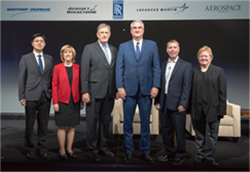Purdue Engineering Cislunar Initiative Sets Priorities for Moon Exploration Written 20 August 2019
In This Section

Mung Chiang, dean of engineering at Purdue University; Lisa Teague, head of research and technology, Rolls-Royce Corporation; Dan Dumbacher, AIAA executive director; Eric Holcomb, governor of Indiana; David Spencer, director of the Space Flight Projects Laboratory at Purdue University; and Kathleen Howell, an expert on multibody dynamics and a professor at Purdue University, panelists on “Partnering Advances in Aerospace,” Aug. 20, at the 2019 AIAA Propulsion and Energy Forum in Indianapolis.
by Hannah Godofsky, AIAA Communications
AIAA PROPULSION AND ENERGY FORUM, Indianapolis, August 20, 2019 — Researchers who are part of the Purdue Engineering Cislunar Initiative said during the “Partnering Advances in Aerospace” panel here that the orbital economy is booming and that the initiative wants to help expand it.
“Right now, the orbital economy generates about $350 billion per year in revenue, and that’s growing,” said David Spencer, director of the Space Flight Projects Laboratory at Purdue. “What we’re trying to do with the Purdue Engineering Cislunar Initiative is to advance that economy to include cislunar space, the region that encompasses the moon and lunar orbit.”
Spencer said technology advancements, including launch vehicles that can make multiple stops and inflatable habitats, will enable this new economic expansion.
Kathleen Howell, an expert on multibody dynamics and a professor at Purdue, added, “We need an architecture that can support a space-based economy but can also expand the science enterprise as well as human exploration, both to the moon and beyond.”
Howell explained that the Purdue Engineering Cislunar Initiative is interested in serving as a focal point for the broader discussion. She described current and future work on this effort at Purdue, including plans for an incubator to support proposal developments and plans to bring technical experts to campus for a policy fellows program.
“One of the things we’ve learned is that there needs to be more technical presence in this policy arena,” Howell said.
Mung Chiang, dean of engineering at Purdue, summed it up effectively: “The flight of 50 years starts on year one.”
